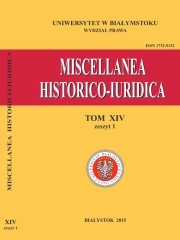Ustrój XVIII-wiecznego miasta Białystok
The Political System of the Eighteenth Century’s City of Białystok
Author(s): Karol ŁopateckiSubject(s): Politics / Political Sciences, History, Law, Constitution, Jurisprudence, Government/Political systems, 18th Century
Published by: Wydawnictwo Uniwersytetu w Białymstoku
Keywords: Białystok; system of private cities; municipal judiciary; landwójt; mayor; town council; kahal military; garrison
Summary/Abstract: Białystok received city rights in 1692, known privileges had been passed in the years 1749 and 1760. In spite of the fact that these acts granted basic principles of the urban system, the owners of Bialystok were able to freely decide changes that could have violated the existing order. An important change was the establishment of the landwójt office in 1769. The landwójt (mayor) was a position appointed for life by the Branicki family. The landw´ojt was able to subdue the municipal authorities and the city judiciary. Białystok was an extremely diverse city in terms of its organization. In this article I was able to isolate four loosely interconnected authority structures: city – suburbs – the Jewish community – military garrison. This, diverse in form, urban organization was supervised by courtly suzerainty. Until the 1st half of XVIII century owners could have made necessary steps independently (to a great extent). With the development of Białystok they handed over their powers (including judicial power) to the General Commissioner of the Podlasie Estates. Izabela Branicka decided in 1772 to appoint a special official – a governor. His sole task was to manage the city. An important arrangement was the division of Białystok into two areas: the left-bank, where the city “proper” was located, and the right-bank, which, despite frequently naming it a “new city”, was not a distinct urban structure. Unification was made under the reign of War and Domain Chamber and the whole process ended with the lease of Białystok by Izabela Branicka to the King of Prussia in 1802.
Journal: Miscellanea Historico-Iuridica
- Issue Year: 14/2015
- Issue No: 1
- Page Range: 349-379
- Page Count: 31
- Language: Polish

